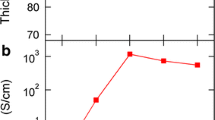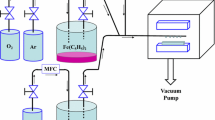Abstract
In the present study, flexible organic poly(3,4-ethylenedioxythiophene):poly(styrene sulfonate) (PEDOT:PSS) films were employed as working electrodes for the facile electrodeposition of tellurium (Te). Dendritic Te nanostructures were successfully deposited at a current of 8 mA/cm2 for 700 s at 25 °C, using Na2TeO3 as the Te source and HNO3 as the electrolyte. The phase and morphology of the resulting dendritic nanostructures were characterized by X-ray diffraction, energy-dispersive spectrometry, and scanning electron microscopy. It was found that the deposition temperature had a remarkable influence on the morphologies of the samples. A certain concentration of HNO3 was indispensable in the formation of dendritic Te nanostructures. High deposition current density promoted the formation of dendritic Te nanostructures and the morphologies could be affected by the Na2TeO3 concentration. It is expected that flexible organic PEDOT:PSS film working electrodes may provide a facile and general method for synthesizing materials with a wide array of applications.










Similar content being viewed by others
References
Tangney P, Fahy S (2002) Density-functional theory approach to ultrafast laser excitation of semiconductors: application to the A 1 phonon in tellurium. Phys Rev B 65:054302–054304
Beauvais J, Lessard RA, Galarneau P, Knystautas EJ (1990) Self-developing holographic recording in Li-implanted Te thin films. Appl Phys Lett 57:1354–1356
Zhao AW, Ye CH, Meng GW, Zhang LD, Ajayan PM (2003) Tellurium nanowire arrays synthesized by electrochemical and electrophoretic deposition. J Mater Res 18:2318–2322
Lu J, Xie Y, Xu F, Zhu L (2002) Study of the dissolution behavior of selenium and tellurium in different solvents-a novel route to Se, Te tubular bulk single crystals. J Mater Chem 12:2755–2761
Siciliano T, Filippo E, Genga A, Micocci G, Siciliano M, Tepore A (2009) Single-crystalline Te microtubes: synthesis and NO2 gas sensor application. Sens Actuators B 142:185–190
Liu ZP, Hu ZK, Xie Q, Yang BJ, Wu J, Qian YT (2003) Surfactant-assisted growth of uniform nanorods of crystalline tellurium. J Mater Chem 13:159–162
Zhu YJ, Wang WW, Qi RJ, Hu XL (2004) Microwave-assisted synthesis of single crystalline tellurium nanorods and nanowires in ionic liquids. Angew Chem Int Ed 116:1434–1438
Cho SO, Lee EJ, Lee HM, Kim JG, Kim YJ (2006) Controlled synthesis of abundantly branched, hierarchical nanotrees by electron irradiation of polymers. Adv Mater 18:60–65
Sukhanova A, Baranov AV, Perova TS, Cohen JHM, NaPbev I (2006) Controlled self-assembly of nanocrystals into polycrystalline fluorescent dendrites with energy-transfer properties. Angew Chem Int Ed 45:2048–2052
Cao MH, Liu TF, Gao S, Sun GB, Wu XL, Hu CW, Wang ZL (2005) Single-crystal dendritic micro-pines of magnetic α-Fe2O3: large-scale synthesis, formation mechanism, and properties. Angew Chem Int Ed 44:4197–4201
Zhu HT, Zhang H, Liang JK, Rao GH, Li JB, Liu GY, Du ZM, Fan HM, Luo J (2011) Controlled synthesis of Tellurium nanostructures from nanotubes to nanorods and nanowires and their template applications. J Phys Chem C 115:6375–6380
Mayers B, Xia YN (2002) One-dimensional nanostructures of trigonal tellurium with various morphologies can be synthesized using a solution-phase approach. J Mater Chem 12:1875–1881
Chen HY, Lu HL, Nie YG, Zhang JH, Zhang MZ, Dai QQ, Gao SY, Kan SH, Li DM, Zou GT (2007) The fabrication of Te nanowires with different orientations by vacuum vapor deposition. Phys Lett A 362:61–65
Kim KH, Zheng JY, Shin W, Kang YS (2012) Preparation of dendritic NiFe films by electrodeposition for oxygen evolution. RSC Adv 2:4759–4767
Yi SJ, Sun LM, Lenaghan SC, Wang YZ, Chong XY, Zhang ZL, Zhang MJ (2013) One-step synthesis of dendritic gold nanoflowers with high surface-enhanced Raman scattering (SERS) properties. RSC Adv 3:10139–10144
She GW, Shi WS, Zhang XH, Wong TL, Cai Y, Wang N (2009) Template-free electrodeposition of one-dimensional nanostructures of tellurium. Cryst Growth Des 9:663–666
Zheng JY, Kang MJ, Song G, Son SI, Suh SP, Kim CW, Kang YS (2012) Morphology evolution of dendritic Fe wire array by electrodeposition, and photoelectrochemical properties of α-Fe2O3 dendritic wire array. Cryst Eng Comn 14:6957–6961
Qiu R, Zhang XL, Qiao R, Li Y, Kim YI, Kang YS (2007) CuNi dendritic material: synthesis, mechanism discussion, and application as glucose sensor. Chem Mater 19:4174–4180
Wang YM, Zhao DD, Zhao YQ, Xu CL, Li HL (2012) Effect of electrodeposition temperature on the electrochemical performance of a Ni(OH)2 electrode. RSC Adv 2:1074–1082
Arenas JV, Pritzker M (2013) Effect of electrolyte and agitation on the anomalous behavior and morphology of electrodeposited Co-Ni alloys. J Solid State Electrochem 17:419–433
Roncali J (1992) Conjugated poly(thiophenes): synthesis, functionalization, and applications. Chem Rev 92:711–738
Nie GM, Cai T, Xu JK, Zhang SS (2008) Low-potential facile electrosyntheses of high-quality free-standing poly(fluorene-9-carboxylic acid) films. Electrochem Commun 10:186–189
Hillman AR, Mallen EF (1987) Nucleation and growth of polythiophene films on gold electrodes. J Electroanal Chem 220:351–367
Shi GQ, Jin S, Xue G, Li C (1995) A conducting polymer film stronger than aluminum. Science 267:994–996
Prathish KP, Carvalho RC, Brett CMA (2014) Highly sensitive poly(3,4-ethylenedioxythiophene) modified electrodes by electropolymerisation in deep eutectic solvents. Electrochem Commun 44:8–11
Huynh TP, Pieta P, D’Souza F, Kutner W (2013) Molecularly imprinted polymer for recognition of 5-fluorouracil by RNA-type nucleobase pairing. Anal Chem 85:8304–8312
Song ZP, Zhou HS (2013) Towards sustainable and versatile energy storage devices: an overview of organic electrode materials. Energy Environ Sci 6:2280–2301
Alemu D, Wei HY, Ho KC, Chu CW (2012) Highly conductive PEDOT:PSS electrode by simple film treatment with methanol for ITO-free polymer solar cells. Energy Environ Sci 5:9662–9671
Kim N, Kee S, Lee SH, Lee BH, Kahng YH, Jo YR, Kim BJ, Lee K (2014) Highly conductive PEDOT:PSS nanofibrils induced by solution-processed crystallization. Adv Mater 26:2268–2272
Du Y, Shen SZ, Cai KF, Casey PS (2012) Research progress on polymer–inorganic thermoelectric nanocomposite materials. Prog Polym Sci 37:820–841
Li Y, Yue GT, Chen XY, He BL, Chu L, Chen HY, Wu JH, Tang QW (2013) Application of poly(3,4-ethylenedioxythiophene):polystyrenesulfonate in polymer heterojunction solar cells. J Mater Sci 48:3528–3534. doi:10.1007/s10853-013-7147-6
Mali SS, Patil PS, Bhosale PN, Hong CK (2014) Novel hybrid solar cells based on α-copper phthalocyanine–cadmium sulfide planar heterojunction. J Mater Sci 49:5100–5111. doi:10.1007/s10853-014-8218-z
Groenendaal L, Jonas F, Freitag D, Pielartzik H, Reynolds JR (2000) Poly(3,4-ethylenedioxythiophene) and its derivatives: past, present, and future. Adv Mater 12:481–494
Shi H, Liu CC, Xu JK, Song HJ, Lu BY, Jiang FX, Zhou WQ, Zhang G, Jiang QL (2013) Facile fabrication of PEDOT: PSS/polythiophenes bilayered nanofilms on pure organic electrodes and their thermoelectric performance. ACS Appl Mater Interfaces 5:12811–12819
Song HJ, Liu CC, Zhu HF, Kong FF, Lu BY, Xu JK, Wang JM, Zhao F (2013) Improved thermoelectric performance of free-standing PEDOT:PSS/Bi2Te3 films with low thermal conductivity. J Electron Mater 42:1268–1274
Mo DL, Zhou WQ, Ma XM, Xu JK, Jiang FX, Zhu DH (2015) Alkyl functionalized bithiophene end-capped with 3,4-ethylenedioxythiophene units: synthesis, electropolymerization and the capacitive properties of their polymers. Electrochim Acta 151:477–488
Wei WF, Cui XW, Chen WX, Ivey DG (2011) Manganese oxide-based materials as electrochemical supercapacitor electrodes. Chem Soc Rev 40:1697–1721
Xiao F, Yoo BY, Ryan MA, Lee KH, Myung NV (2006) Electrodeposition of PbTe thin films from acidic nitrate baths. Electrochim Acta 52:1101–1107
Cao XZ, Song TY, Wang XQ (1994) Inorganic chemistry 3rd edn. High Education Publication, Beijing
Lyahovitskaya V, Feldman Y, Zon I, Wachtel E, Lubomirsky I, Roytburd AL (2005) Polycrystalline macro-domains formed by self-organization of ferroelectric grains. Adv Mater 17:1956–1960
Zhang YM, Ni YH, Wang XM, Xia J, Hong JM (2011) Polycrystalline Cu7Te4 dendritic microstructures constructed by spherical nanoparticles: fast electrodeposition, influencing factors, and the shape evolution. Cryst Growth Des 11:4368–4377
Ni YH, Zhang YM, Hong JM (2011) Hierarchical Pb microstructures: a facile electrochemical synthesis, shape evolution and influencing factors. Cryst Eng Comm 13:934–940
Li GR, Yao CZ, Lu XH, Zheng FL, Feng ZP, Yu XL, Su CY, Tong YX (2008) Facile and efficient electrochemical synthesis of PbTe dendritic structures. Chem Mater 20:3306–3314
Acknowledgements
This work was supported by the National Natural Science Foundation of China (51303073 & 51203070), Jiangxi Provincial Department of Education (YC2013-S270 & GJJ13565), and Jiangxi Provincial Department of Science and Technology (20122BAB216011 & 20142BAB216032), Training Plan for the Main Subject of Academic Leaders of Jiangxi Province.
Author information
Authors and Affiliations
Corresponding author
Additional information
Qinglin Jiang and Congcong Liu have contributed equally to this work.
Rights and permissions
About this article
Cite this article
Jiang, Q., Liu, C., Lu, B. et al. PEDOT:PSS film: a novel flexible organic electrode for facile electrodeposition of dendritic tellurium nanostructures. J Mater Sci 50, 4813–4821 (2015). https://doi.org/10.1007/s10853-015-8818-2
Received:
Accepted:
Published:
Issue Date:
DOI: https://doi.org/10.1007/s10853-015-8818-2




